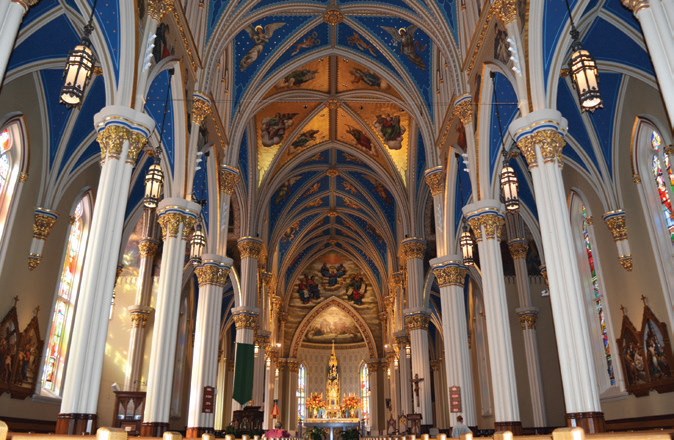Since the Basilica of the Sacred Heart at the University of Notre Dame (UND) in Northern Indiana began broadcasting Mass in 2002, it has undergone several technological upgrades, but none as comprehensive as the most recent effort. Undertaken in partnership with Milwaukee-based DSH Audio Visions (DSH-AV), the project has significantly increased clarity and intelligibility in the Basilica proper and for those streaming Mass remotely.
When the Basilica first contacted DSH-AV in 2018, the primary concern was to improve the audio quality for streaming/broadcast with the provision of a Dante backbone to link the Basilica with UND’s Rex and Alice A. Martin Media Center. “The audio quality for broadcast wasn’t ideal, and they didn’t have an independent mix apart from the house mix,” explains David Hosbach, president and principal design consultant of DSH-AV. “But as we got into it, it became a major audio update, stemming from the need to improve the overall sound in the Basilica, issues with the Basilica’s wireless mics, a lack of clarity, and echoes throughout the space.”
To improve both streaming and in-house sound required looking at the audio systems and connectivity as a whole for broadcast, which, says Kate Barrett, associate director for liturgy for Campus Ministry at UND, “Became more important than we ever realized in the past two years.” Additionally, they required the ability to record effectively in the space, Barrett adds, citing an upcoming album project featuring one of their choirs. “We want to be able to capture that, for streaming and recordings, in a way that people can hear how gorgeous it sounds here.”
In doing so, preserving the atmosphere and aesthetics in the historic church was of paramount importance. “It’s not like going into a contemporary church, installing line arrays, subwoofers, and a large format console and calling it a day,” Hosbach says. “Every liturgical church is unique. Even within denominations, there are variations on the worship setting.”
Understanding Expectations
Although DSH-AV takes on all manner of projects, Hosbach has considerable experience in working with traditional churches. “I grew up in a ministry family. I understand how essential it is for every worshiper to hear the Word clearly and worship in a space that comes alive acoustically and architecturally,” he notes.
Beyond his work as a system designer, Hosbach has also directed traditional choirs and contemporary praise ensembles and served on church boards/planning committees. “So, I understand liturgy and what churches are trying to do, particularly if they want a space that’s reverberant and traditional,” he adds.

Constructed in 1868, the Basilica has served as the mother church of the Congregation of the Holy Cross in the United States. It also functions as a central place for worship for UND and the broader community in providing a beautiful place of worship for students, faculty, staff, alumni, members of Sacred Heart Parish, and visitors.
It’s a truly spectacular place, featuring a 230-foot-high bell tower, a traditional cruciform design, and 44 stained-glass windows created in France, and several murals painted by Luigi Gregori (who, before a 17-year engagement at UND, was artist in residence at the Vatican). Measuring 275 feet long and 114 feet wide, the facility is also a challenging space for audio reinforcement, but Hosbach’s personal approach and lengthy experience providing AV systems for other traditional liturgical churches helped in establishing and maintaining a high degree of trust throughout the design/installation process.
“That’s something we really appreciated,” Barrett says. “While we wanted to have the tools to help people ‘pray better,’ we didn’t want those to get in the way of what we’re doing. We were willing to sacrifice a little bit of what would give us A-plus sound to maintain that, and not have speakers in certain places. And David listened to our concerns and worked with us to balance that.”
Video, Then Audio
The first camera system in the Basilica was an SD analog system installed in 2002 that relied on Sony EFP-style cameras. In 2015 the Basilica decided to replace those with an HD setup comprised of seven Panasonic HE130s with centralized control in the Martin Media Center.
“We put them up on top of the capitals,” says Scott Rinehart, director of broadcast and streaming technology at UND, “so you have to look closely to see them; two cameras in the back, three down the main aisle, one in each transept, and one farther back. The idea was to be able to follow processions throughout the sanctuary during, for example, Easter services, while still being able to capture the choir and other musical performances taking place in the choir loft.
While the cameras provided better visuals, “We were still using our old microphones with XLR [cables] running into the Basilica’s basement,” he adds. “That’s where the audio console was because there was no other place to put it, so they sent that mix over here to be inserted into the video program.”
An audio upgrade was something they considered, briefly, at that time. “But in hindsight, we’re fortunate we didn’t take on audio at the same time. The video installation was a challenge in and of itself because of the historical nature of the building and the importance of the building to the university. Back then we were more interested in getting the cameras up and running and knew what we wanted to achieve. Conceptually, that was easy.”
Conversely, the ideal means of addressing the audio needs and providing connectivity between the Basilica and the Martin Media Center wasn’t clear. “Nobody else on campus was using Dante and, quite frankly, we didn’t want to put the broadcast at risk with a technology we didn’t understand,” Rinehart explains.
Between 2016 and 2019, however, the UND Athletic Department began installing Dante networks in sporting venues, leading to an interest in similar infrastructure for the Basilica. “Our classroom AV was moving in that direction, too,” adds Daniel Skendzel, executive director of Notre Dame Studios and Teaching & Learning Technologies. “But we also had a new organ coming in and didn’t want to do something that would need to be changed after that.”
After the organ replacement finished out in 2018, the technologies that would comprise the eventual audio upgrade remained an unknown quantity. “With video, we knew what we wanted and worked directly with the integrator,” Skendzel says. “But we didn’t know enough about audio design and what products out there, which led us to DSH-AV. We knew we needed a consultant to help us work with an integrator to do a design and implement it.”
Doubling Up
Hosbach began by upgrading the facility’s aging DSP system to the Symetrix SymNet open architecture platform offering modern audio networking capabilities, with one processor in a rack on the main floor and another in the choir loft. “Now they have an audio signal they can mix there – every input raw – and tune and tweak however they want for broadcast without affecting or being affected by the mix in the Basilica,” Hosbach details.

Next, after evaluating several loudspeaker models, Hosbach delivered a design a comprised primarily of Bose Professional Panaray MSA12X self-powered digital beam-steering arrays, custom painted to match the space and installed by Chris King of Lombard, IL-based GMK Audio-Visual during UND’s 2019/2020 winter break.
“The concept was to have two, independent sound systems because part of the service happens in the center of the cruciform area of the church, but the choir is towards the back of that cross,” King says. “We have two different delay points set up. So the speakers from the center, where Mass takes place, are one system, and then the other is delayed towards the back of the church.”
To provide coverage and clarity throughout the entire Basilica – regardless of how much of the sanctuary was in use, or how many people were in attendance – combinations of single loudspeakers and double and triple stacks of MSA12Xs were deployed, all with white enclosures to blend in. The main arrays are mounted on side walls ahead of the altar platform, augmented by a pair on either side wall of each transept (with one pair providing audio from the altar platform and the other providing sound from the loft).

Additional arrays were deployed to the rear and the side of the altar to provide reinforcement for the approximately 200-capacity rear altar area, and another to cover the Basilica’s Lady Chapel. Hosbach also provided two custom loudspeaker enclosures (each containing two Soundtube RF31 EZ BK drivers) to provide fill from the altar for the choir loft. Additionally, a pair of Innovox CLA-1650 passive line arrays were added to project sound from the loft into the main sanctuary.
Attaining Clarity
Aesthetics and sonics were always top of mind, Hosbach says, explaining that the custom enclosures were constructed by his brother-in-law, a woodworker, painted to blend in with the pipe chest, and placed on the back edge on top of the organ’s forward pipe chest to provide foldback for the choir and organist while remaining invisible from the perspective of the main floor congregation.

“When all is said and done, I don’t think they’ve ever had clarity like this before in the Basilica,” he states. “The congregation can not only hear the liturgy and homily but, since we’re projecting sound forward from the loft and the loudspeakers are all placed, steered, and delayed as they are, wherever people are seated they can hear the music, the choir, a soloist, as if they’re 20 feet – rather than 200 feet – away.”
A variety of new microphones were also brought in, include Sennheiser MKH 8040s as ambient mics, Earthworks FMR Series gooseneck mics (on the ambo oblong pulpit and lectern), a large-diaphragm Earthworks SR 314 for cantors/soloists in the loft, and a Shure ULX-D digital wireless system.

In addition, a pair of pre-existing Sennheiser dual-element mics were re-purposed to pick up signals from the organ and choir as well as to capture more sound of the room, while the existing lapel mics were replaced the Basilica’s existing lapel microphones with Shure TwinPlex TL47 lavaliers. “The wireless mics, altar, ambo and lectern mics, and other ‘liturgical’ mics are mixed in the new Symnet DSP and can be controlled wirelessly from anywhere within the nave using the Symnet ARC-WEB wi-fi connection.”
Aesthetics also played into the wiring of the space and placement of control systems. “With a building this old it’s tricky,” King notes. “You never really know what the construction of the building is like until you get into it.” But having access to both in-house electricians and carpenters helped them find “strategic ways” of installing wiring without impacting aesthetics, he adds.
The existing mixing console was replaced with two Ashly Audio digiMIX18 digital mixers – and neither of them is in the basement. “One takes the mic lines from up in the loft and the other we put to the side of the altar platform,” Hosbach explains, adding that the one at the side of the altar is placed in a cabinet to hide it from view, but it can be used for larger events if more control is required. “All of those inputs are on Dante. They can be remote-controlled using Ashly’s app and a smartphone, and all go to the media center before they hit the processors in the Basilica.”
A Quantum Leap
With the media center on the opposite side of campus from the Basilica, the Dante integration is a game-changer, allowing Skendzel and Rinehart to leverage the campus-wide fiber network to mix for streaming in real-time while controlling the cameras. With each microphone in the Basilica on Dante and the feeds split (one going to the internal processors and the other over fiber to the media center’s Soundcraft console), they can pick and choose the mic feeds best suited to their purposes for Mass or any event taking place in the Basilica.
If there’s an issue of some kind, Rinehart adds, the fix is at his fingertips. “Before, when I was doing daily Mass, if somebody were to change the mix over in the Basilica basement, I’d have to go over there and fix it – not that I’d mind but having the technology and ability to do it like we’re doing now is wonderful.”
“The technical integration with the media center is a quantum leap for us,” Skendzel says. “There were several goals for this project. One, get off analog audio and onto a platform that would allow us to be secure in the knowledge that the Basilica was in good hands, audio-wise, for the next 10 to 15 years. Two, to have a split mix so we could set things up to have a good sound experience in the Basilica, but without the TV broadcast/streaming being dependent on how they were mixing it in this huge, cavernous church.

“Thirdly, fully integrate (the Basilica system) into the Martin Media Center facility so that we didn’t have somebody trying to mix audio in the basement of the Basilica for broadcast. And we saw an immediate improvement as soon as this launched.”
Previous issues such as the amount of reverberation in the broadcast mix are no longer a problem, Rinehart states. “If somebody’s reading at the ambo, for example, and we crank up the ambient mics, we’ll pick up the speakers, and it will get hollow sounding. But we have control of all the mics, so we don’t ride the ambient ones that hot.”
Skendzel credits Hosbach and DSH-AV’s considerable experience for making the process as painless as possible: “David’s work in other cathedral spaces, I think, was key to our success here. One of our requirements was a ‘permanent low profile equipment installation that minimizes visual distraction.’ That’s a direct quote from our original project document. He knew that up front, and with all his religious music experience, he understands those requirements.”
Barrett adds, “We also really appreciated the training David provided to help us use the gear and make the most of it,” explaining that Hosbach made sure that anyone – with or without audio experience – understands the basics. “We have a part-time person who coordinates our liturgical ministers, but they’re all volunteers. And our choirs, cantors and Psalmists are almost entirely students.
“So, David’s help with things as simple as where to point the microphone to get the best sound when you’re singing; how to think about articulation, diction, speed, and volume. That was extremely helpful. Most of our choir directors just turn things on and off, but we have one who understands audio more and is more likely to tweak things. There’s no use having these fabulous tools if you don’t know how to use them.”
As for what they’ve learned from this process and what others looking to update their church can take from it, Rinehart concludes, “It comes back to why are you doing this in the first place? Everyone will come to a different answer, but if you don’t understand the technology, that’s where you can make a big mistake.”




















